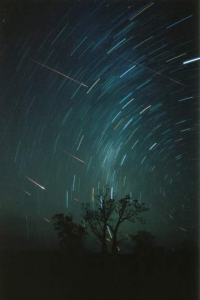ESA scientists capture the Lion's offspring down under
|
Figure 1: The team from left to right: Joe Zender, Detlef Koschny, André Knöfel, Roland Trautner. |
From their remote encampment in the Australian outback, the four-man team from the European Space Research and Technology Centre in the Netherlands successfully observed many thousands of shooting stars while carrying out some groundbreaking trials of new scientific experiments.
Team leader Detlef Koschny and colleague Roland Trautner happily recounted their successful campaign to capture the Lion's offspring.
Question: Were you able to see the Leonids as you had hoped?
Koschny: We were rather nervous because the night of the predicted maximum was cloudy - the first cloudy night we had in Australia - but, fortunately, the clouds went away and we had three hours of beautiful Leonids. We saw the first Leonid fireballs through holes in the clouds - this led to quite spectacular views, since the clouds were black and basically invisible (an unknown experience to a European observer, where there are always lights to illuminate the clouds).
 |
|
Figure 2: This striking image showing some Leonid meteors was taken on 19 November 2001 by Andrew Johnson in western Australia. (15 minute exposure using a super wide-angle lens). |
Trautner: It was a great show - amazing! The most spectacular view for me was in the morning twilight (on 19 November), when the Sun was painting the sky a cobalt blue, the bright stars and the Milky Way were still visible, and there were brilliant fireballs coming in. It was the most beautiful moment of the whole night.
We were very lucky because we had good weather at the end. There had been cloud and smoke from bush fires earlier in the night. The bush fires last for weeks - the farmers just let them burn. We could see them getting closer until they were burning near the road we would have to use on our return journey. Fortunately, the fire was already extinguished when we made our way back to Broome.
Koschny: The weather was a worry to us. There had been thunderstorms around Perth, and we were told that the weather was also bad around Wolf Crater, so we decided to camp out at a dry lake nearer Broome. We made the right decision.
Question: It sounds as if your observations were successful.
Figure 3: André Knöfel and Roland Trautner preparing the spectrograph camera at nightfall.
Koschny: We captured many meteors and fireballs on video - probably several thousand in total, though we won't know the actual numbers until we analyse our tapes. At one point I saw five meteors within one second. My impression was that the activity was fairly constant for about three hours. It was definitely less activity than the 1999 Leonids that we had observed from Spain. There didn't really seem to be a significant peak, but this may be because of the observing geometry. We saw a bright fireball every minute at first, when the radiant (the apparent source of the Leonids) was low above the horizon. Later, as the radiant rose higher in the sky, we could see a lot more, fainter meteors.
Our visual observations were reported via satellite phone to Vladimir Krumov from the International Meteor Organisation, who kindly acted as the coordinator. We obtained about 200 hours of video data from five intensified video cameras. Two of the cameras were equipped with objective gratings, so we were able to successfully record meteor spectra showing both emission and absorption lines, and we can now start to analyse the chemistry of these meteors.
|
Figure 4: The electric field sensor. |
Trautner: We suffered from high temperatures - above 40°C every day. This increased the electric current consumption of the MI probe electronics and blew the fuses. Another problem we encountered was the power supply for our equipment. Fortunately, we were able to recharge our batteries during the day using a solar panel and by linking up to our car batteries and generators. The solar array was very useful - it would have been a disaster if the car batteries had run dry!
After a number of MI probe test runs, the display on the laptop controlling the probe died, so that brought my tests to a sudden end. However, I had run sufficient tests before that to get plenty of useful data. It will be very valuable for assessing the performance of the new instrument architecture.
Question: You mentioned the threat from bad weather, heat and bush fires. Were there any other problems that you had to overcome?
Figure 5: Leonid 2001 observing campaign site in Australia.
Trautner: We were driving around looking for a good site to set up the MI probe when we had an encounter with a farmer's daughter wielding a rifle! She did not realise that her father had given us permission to be on the property and thought we were trespassing. She told us in no uncertain terms to get off the property. It was only after she rang her father that she realised her mistake. She wrote us an apology afterwards.
We also had to keep a look out for lizards. Some of them were up to 1.5 metres long and they looked like small crocodiles! They were very shy, but if we saw any of these animals, we were very respectful! We also saw a lot of other animals - kangaroos, bush turkeys, emus, etc. There were plenty of insects too - sometimes they were a real plague.
Koschny: All in all, it was a fantastic experience. Especially sitting in the outback, with nighttime temperatures above 20 deg C, three hours away from civilisation, seeing the Magellanic Clouds and the Southern Cross, was something I will never forget.
Contact:
Dr. Detlef Koschny
ESTEC Noordwijk
The Netherlands
Tel: +31-71-565-4828
Email: detlef.koschny esa.int
esa.int
